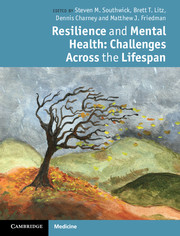Book contents
- Frontmatter
- Contents
- Contributors
- Preface
- Section 1 Pathways to resilience
- Section 2 Resilience across the lifespan
- Section 3 Resilience in families, communities, and societies
- Section 4 Specific challenges
- Section 5 Training for resilience
- 20 Interventions to enhance resilience and resilience-related constructs in adults
- 21 Childhood resilience: adaptation, mastery, and attachment
- 22 Military mental health training: building resilience
- 23 Public health practice and disaster resilience: a framework integrating resilience as a worker protection strategy
- Index
- References
20 - Interventions to enhance resilience and resilience-related constructs in adults
from Section 5 - Training for resilience
Published online by Cambridge University Press: 07 September 2011
- Frontmatter
- Contents
- Contributors
- Preface
- Section 1 Pathways to resilience
- Section 2 Resilience across the lifespan
- Section 3 Resilience in families, communities, and societies
- Section 4 Specific challenges
- Section 5 Training for resilience
- 20 Interventions to enhance resilience and resilience-related constructs in adults
- 21 Childhood resilience: adaptation, mastery, and attachment
- 22 Military mental health training: building resilience
- 23 Public health practice and disaster resilience: a framework integrating resilience as a worker protection strategy
- Index
- References
Summary
Introduction
Most people are exposed to at least one significant trauma during their lifetime. Individuals employed in high-risk occupations, such as soldiers, policemen, and firemen, are typically exposed to many traumas. While numerous training programs have been developed with the goal of increasing resilience and ability to cope with traumatic stress, very few programs and interventions have been subjected to rigorous scientific evaluation. As a result, currently there exists little empirical evidence to support specific approaches to enhancing resilience and preventing the development of psychopathology in the face of stress and trauma. Nevertheless, given recent interest in the development and enhancement of resilience (Meichenbaum & Jaremko, 1983; Meichenbaum, 1985; Maddi, 2002; Davidson et al., 2005; Defense Centers of Excellence, 2009), we believe there is value in reviewing published research on interventions designed to enhance constructs that are related to resilience, such as hardiness, coping self-efficacy, and stress inoculation, as well as factors that are associated with resilience, such as optimism and social support. As noted in earlier chapters, there is no single definition and no agreed upon criteria for resilience. This makes it challenging to evaluate existing treatments and interventions designed to enhance resilience.
The Preface gives a variety of definitions of resilience. Resilience has been defined in terms of protective factors associated with growing up in disadvantaged environments (Garmezy, 1974; Garmezy & Streitman, 1974), successful adaptation to adversity (Luthar et al., 2000), a “class of phenomena characterized by good outcomes in spite of serious threats to adaptation or development” (Masten, 2001, p. 228), enhanced psychobiological regulation of stress hormones (Charney, 2004), and symptom-free functioning following trauma exposure (Bonanno et al., 2006). In general, resilience may be understood as “the process of adapting well in the face of adversity, trauma, tragedy, threats, or even significant sources of stress. Further, it may be understood as the ability to ‘bounce back’ from difficult experiences” (American Psychological Association, 2010, p. 2).
- Type
- Chapter
- Information
- Resilience and Mental HealthChallenges Across the Lifespan, pp. 289 - 306Publisher: Cambridge University PressPrint publication year: 2011
References
- 20
- Cited by



